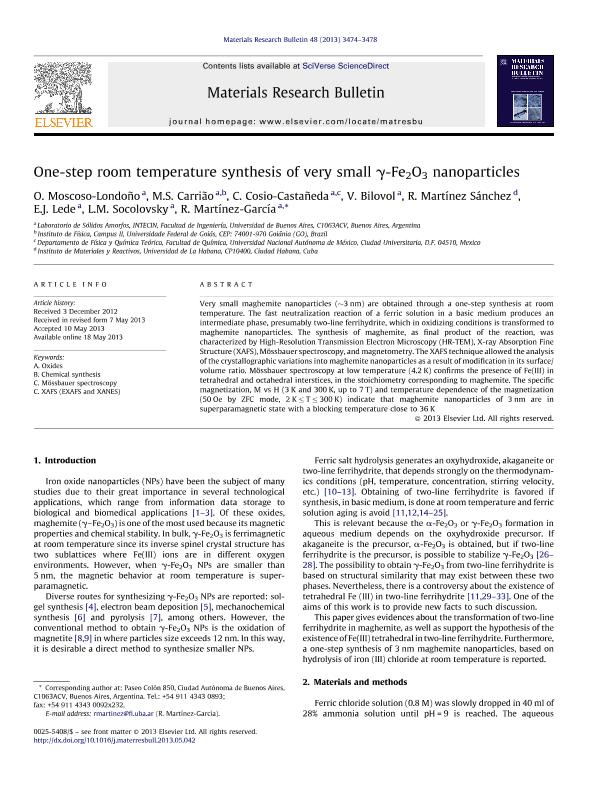Artículo
One-step room temperature synthesis of very small g-Fe2O3 nanoparticles
Moscoso Londoño, Oscar ; Carrião Dos Santos, Marcus
; Carrião Dos Santos, Marcus ; Cosio Castañeda, C.; Bilovol, Vitaliy
; Cosio Castañeda, C.; Bilovol, Vitaliy ; Martinez Sanchez, R.; Lede, Eduardo Javier
; Martinez Sanchez, R.; Lede, Eduardo Javier ; Socolovsky, Leandro Martin
; Socolovsky, Leandro Martin ; Martinez Garcia, Ricardo
; Martinez Garcia, Ricardo
 ; Carrião Dos Santos, Marcus
; Carrião Dos Santos, Marcus ; Cosio Castañeda, C.; Bilovol, Vitaliy
; Cosio Castañeda, C.; Bilovol, Vitaliy ; Martinez Sanchez, R.; Lede, Eduardo Javier
; Martinez Sanchez, R.; Lede, Eduardo Javier ; Socolovsky, Leandro Martin
; Socolovsky, Leandro Martin ; Martinez Garcia, Ricardo
; Martinez Garcia, Ricardo
Fecha de publicación:
05/2013
Editorial:
Elsevier
Revista:
Materials Research Bulletin
ISSN:
0025-5408
Idioma:
Inglés
Tipo de recurso:
Artículo publicado
Clasificación temática:
Resumen
Very small maghemite nanoparticles (~3 nm) are obtained through a one-step synthesis at room temperature. The fast neutralization reaction of a ferric solution in a basic medium produces an intermediate phase, presumably two-line ferrihydrite, which in oxidizing conditions is transformed to maghemite nanoparticles. The synthesis of maghemite, as final product of the reaction, was characterized by High-Resolution Transmission Electron Microscopy (HR-TEM), X-ray Absorption Fine Structure (XAFS), Mössbauer spectroscopy, and magnetometry. The XAFS technique allowed the analysis of the crystallographic variations into maghemite nanoparticles as a result of modification in its surface/volume ratio. Mössbauer spectroscopy at low temperature (4.2 K) confirms the presence of Fe(III) in tetrahedral and octahedral interstices, in the stoichiometry corresponding to maghemite. The specific magnetization, M vs H (3 K and 300 K, up to 7 T) and temperature dependence of the magnetization (50 Oe by ZFC mode, 2 K < T < 300 K) indicate that maghemite nanoparticles of 3 nm are in superparamagnetic state with a blocking temperature close to 36 K.
Palabras clave:
Oxides
,
Chemical Synthesis
,
Mossbauer Spectroscopy
,
Xafs (Exafs And Xanes)
Archivos asociados
Licencia
Identificadores
Colecciones
Articulos(INTECIN)
Articulos de INST.D/TEC.Y CS.DE LA ING."HILARIO FERNANDEZ LONG"
Articulos de INST.D/TEC.Y CS.DE LA ING."HILARIO FERNANDEZ LONG"
Citación
Moscoso Londoño, Oscar; Carrião Dos Santos, Marcus; Cosio Castañeda, C.; Bilovol, Vitaliy; Martinez Sanchez, R.; et al.; One-step room temperature synthesis of very small g-Fe2O3 nanoparticles; Elsevier; Materials Research Bulletin; 48; 5-2013; 3474-3478
Compartir
Altmétricas



